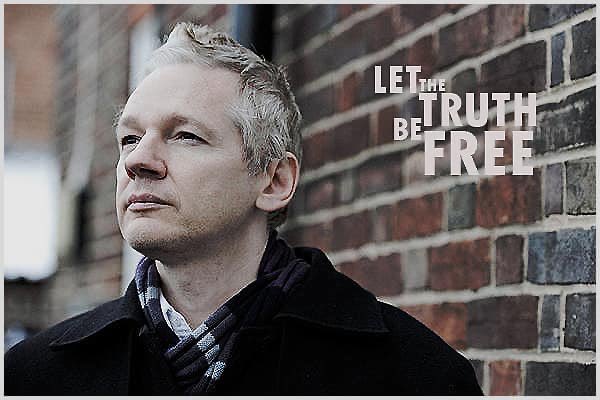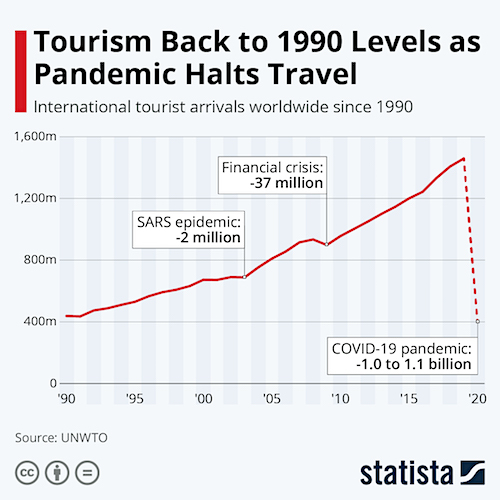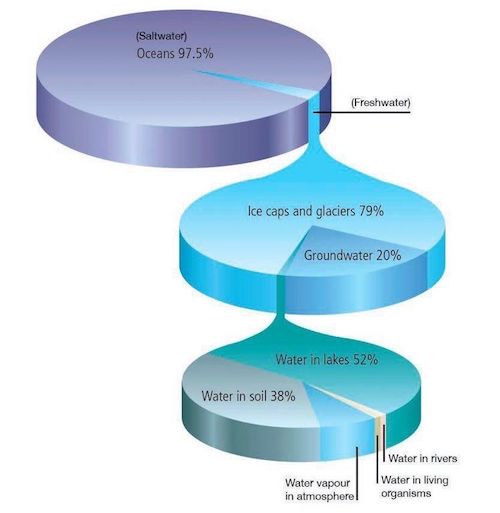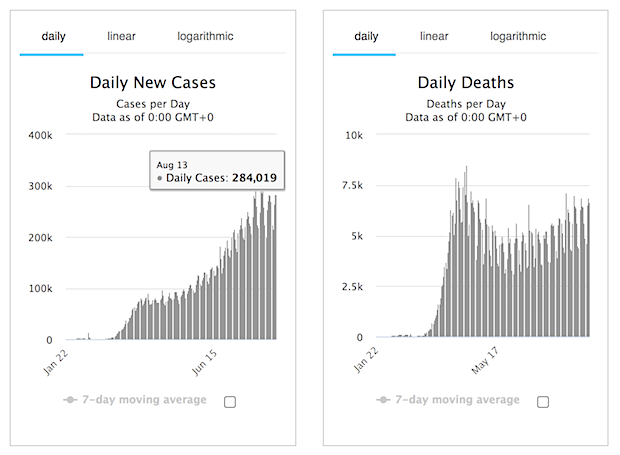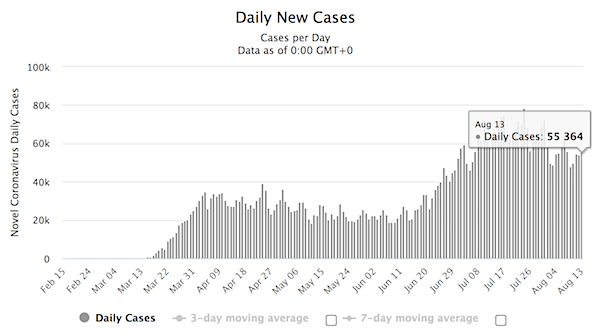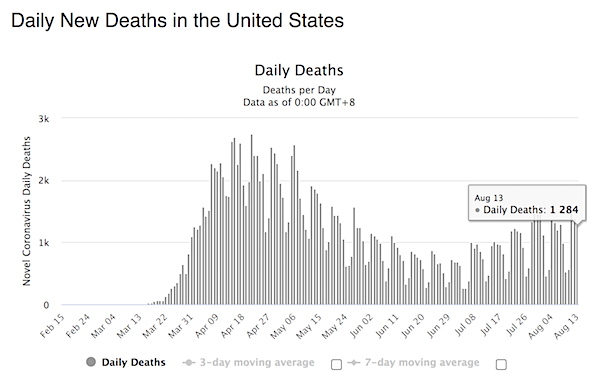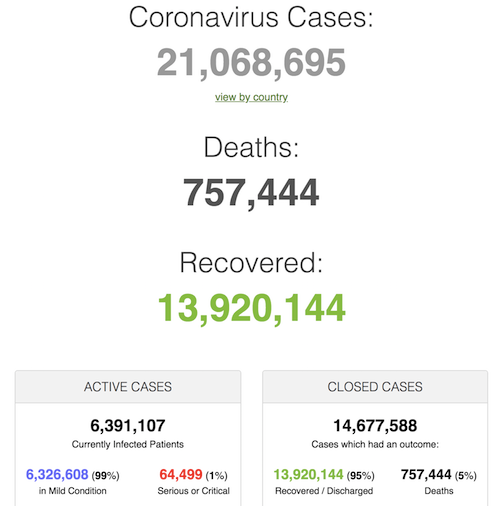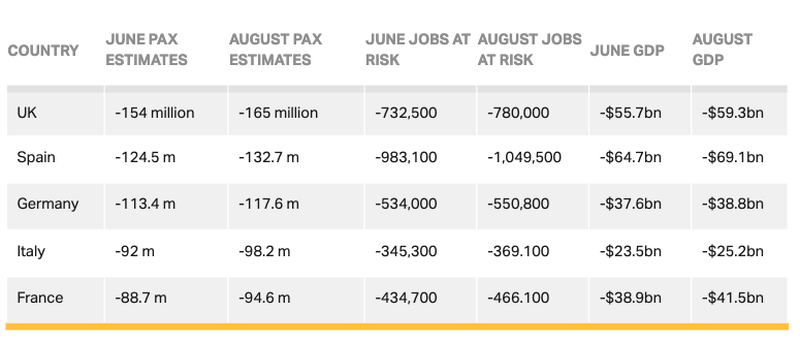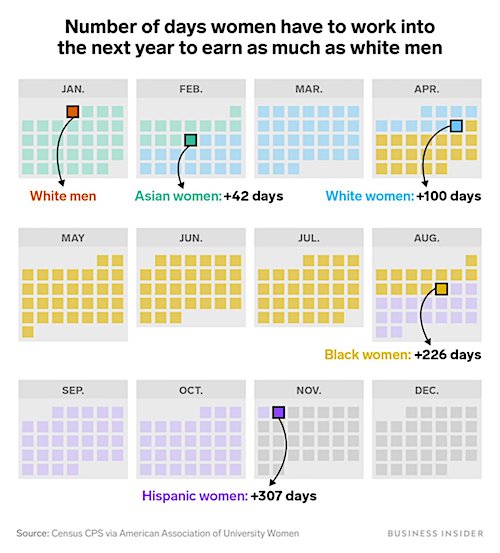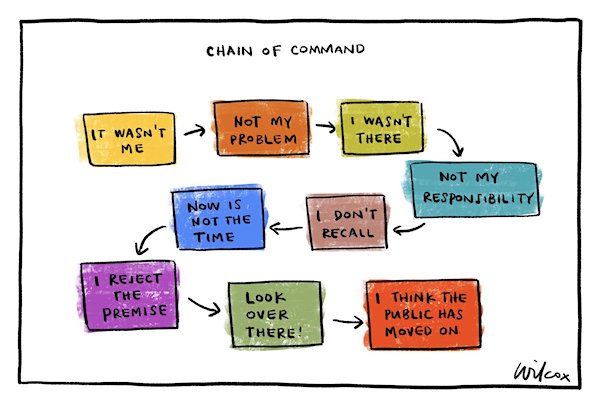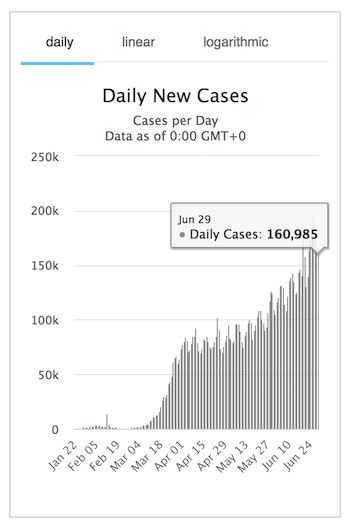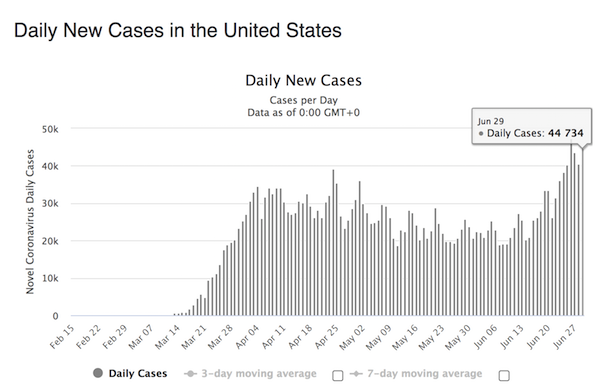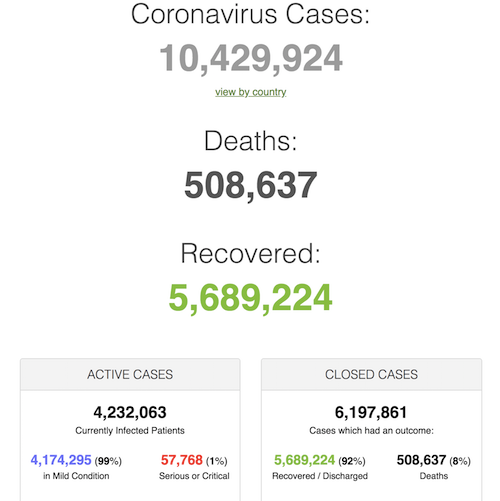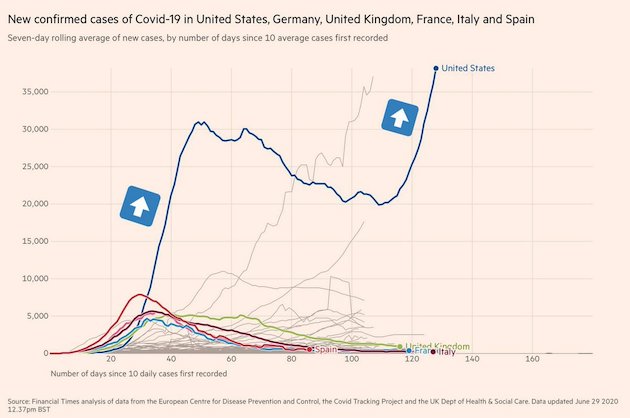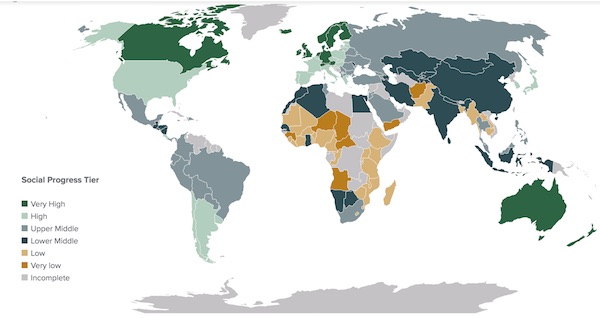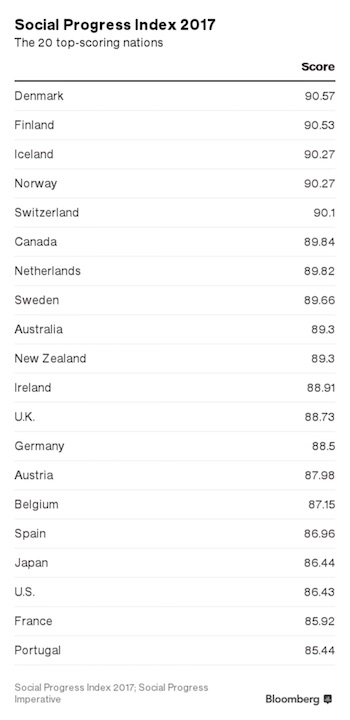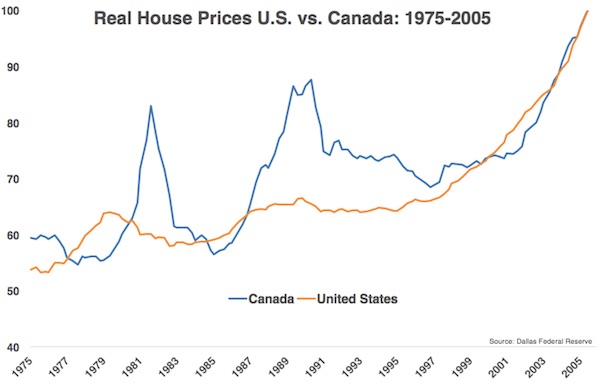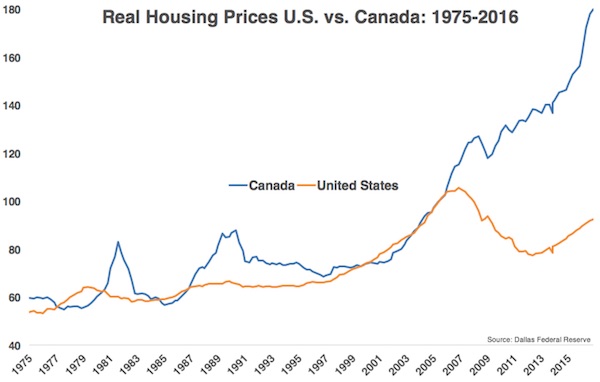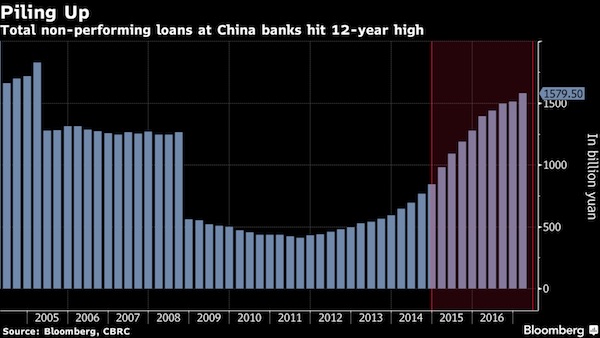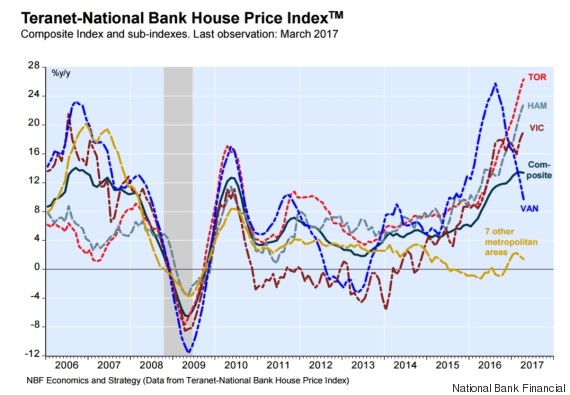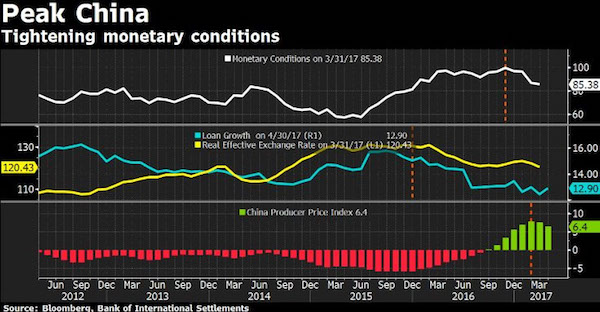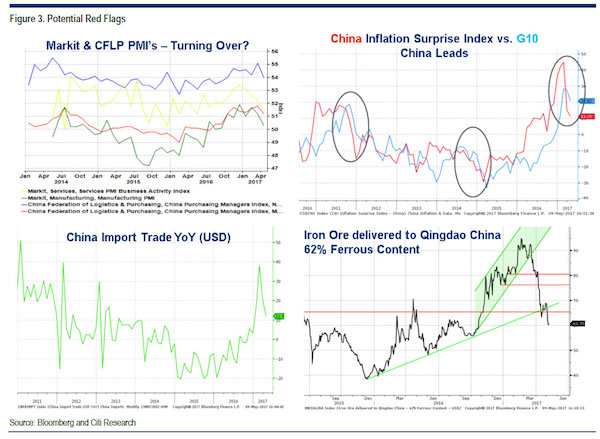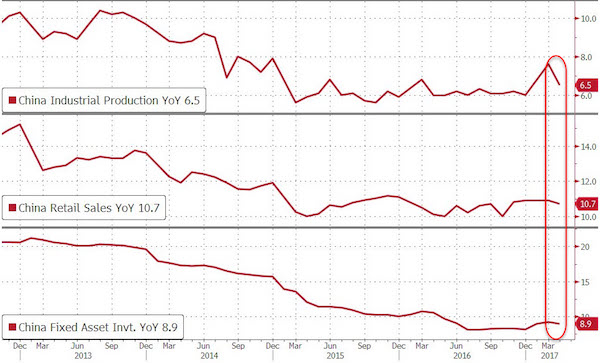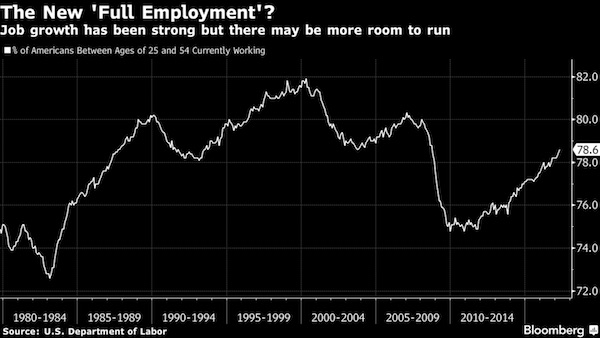
Ito Shinsui Snowy night 1923

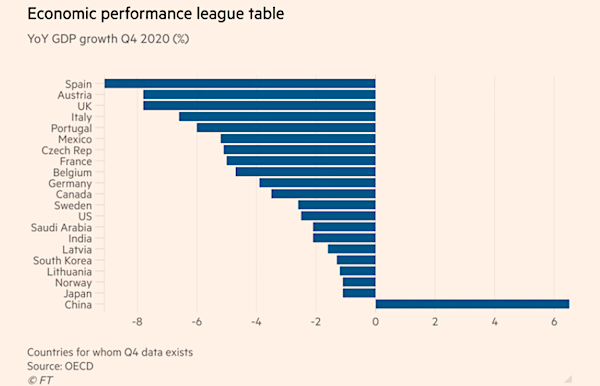

Our daily good news segment.
• Mutations Made Coronavirus 8 Times More Infectious Than Original (RT)
New research has found that a mutation in the spike protein of SARS-CoV-2, present in variants from the United Kingdom, South Africa, and Brazil, can make the virus up to eight times more infectious than the original. The new research into the D614G mutation on the spike protein in SARS-CoV-2, present in all the latest variants currently plaguing healthcare systems the world over, was led by researchers at New York University, the New York Genome Center, and Mount Sinai. “Confirming that the mutation leads to more transmissibility may help explain, in part, why the virus has spread so rapidly over the past year,” said Neville Sanjana, assistant professor of biology at NYU, who added that the mutation has reached “near universal prevalence” among the coronavirus variants spreading across the globe.
The Mount Sinai researchers injected a virus with the D614G mutation into human lung, liver, and colon cells and compared it against cells from the original strain detected in Wuhan at the start of the pandemic. They found a whopping eight-fold increase in transmissibility between the two strains, with the mutated spike protein making the virus more resilient to being split by other proteins in the human immune system, highlighting the importance of continued vaccine research and development to combat this hardier version. “…[O]ur experimental data was pretty unambiguous – the D614G variant infects human cells much more efficiently than the wild type,” said Zharko Daniloski, a postdoctoral fellow in Sanjana’s lab at NYU and the study’s co-first author.
Thankfully, however, the mutation has not yet been linked to more intense progression of Covid-19 leading to more severe forms of the disease or an increase in hospitalization. On the other hand, this does pose another issue: the current generation of vaccines were developed based on the original Wuhan-variant spike protein structure, highlighting the need for booster vaccines or even annual vaccination programs to halt the spread of the coronavirus for good.

More good news.
• Pfizer, Moderna Vaccines Make 3x Less Antibodies vs South African Strain (RT)
Vaccines developed by US companies Pfizer/BioNTech and Moderna are producing fewer antibodies against the coronavirus mutation that has emerged in South Africa, according to studies reported in the New England Journal of Medicine. A lab study jointly conducted by Pfizer/BioNTech and researchers at the University of Texas in Galveston showed that the neutralization of the South African strain “was weaker by approximately two thirds,” but concluded that it was “unclear what effect” that would have on protection the vaccine provided from the disease. This is according to the letter by the researchers published on Wednesday in NEJM, the oldest US medical journal.
Another study conducted by Moderna and the National Institute of Allergy and Infectious Diseases – whose head, Dr. Anthony Fauci, is the Biden administration’s “coronavirus czar” at the moment – showed “reductions by a factor of 2.7” in the titers of neutralizing antibodies against the variant known as the B.1.351 – and by a factor of 6.4 when pitted against the full range of South African mutations. “Protection against the B.1.351 variant conferred by the mRNA-1273 vaccine remains to be determined,” says the letter from the Moderna/NIAID researchers, also published by NEJM on Wednesday. Moderna said it is working on booster shots if needed. Pfizer and BioNTech are also preparing to develop an update or a booster shot if needed, according to a statement cited by Bloomberg.
In a statement released in January, ahead of the study’s review, they said the performance of their vaccine was “slightly lower” against the South African strain when compared to other mutations, but that “small differences in viral neutralization observed in these studies are unlikely to lead to a significant reduction in the effectiveness of the vaccine.” South Africa has halted the vaccination with Astra Zeneca’s formula after a study showed it didn’t work as well in preventing Covid-19 caused by the mutant strain. President Cyril Ramaphosa took the Johnson & Johnson vaccine on Wednesday.

We’re on a roll.
• 130 Countries Have Not Received A Single Covid Vaccine Dose (G.)
The UN secretary general, António Guterres, has sharply criticised the “wildly uneven and unfair” distribution of Covid vaccines, saying 10 countries have administered 75% of all vaccinations and demanding a global effort to get all people in every country vaccinated as soon as possible. The UN chief told a high-level meeting of the UN security council on Wednesday that 130 countries had not yet received a single dose of vaccine. “At this critical moment, vaccine equity is the biggest moral test before the global community,” said. Guterres called for an urgent global vaccination plan to bring together those with the power to ensure equitable vaccine distribution – scientists, vaccine producers and those who can fund the effort.
He called on the world’s major economic powers in the Group of 20 to establish an emergency taskforce to establish a plan and coordinate its implementation and financing. He said the taskforce should have the capacity “to mobilise the pharmaceutical companies and key industry and logistics actors”. Guterres said Friday’s meeting of the Group of Seven major industrialised nations – the United States, Germany, Japan, Britain, France, Canada and Italy – “can create the momentum to mobilise the necessary financial resources”. Thirteen ministers addressed the virtual council meeting organised by Britain on improving access to Covid vaccinations, including in conflict areas.
[..] China’s foreign minister, Wang Yi, criticised the growing “immunity divide” and called on the world to “come together to reject ‘vaccine nationalism,’ promote fair and equitable distribution of vaccines, and, in particular, make them accessible and affordable for developing countries, including those in conflict”. At the WHO’s request, he said, China will contribute 10m doses of vaccines to Covax “preliminarily”. China has donated vaccines to 53 developing countries including Somalia, Iraq, South Sudan and Palestine, which is a UN observer state. It has also exported vaccines to 22 countries, he said, adding that Beijing has launched research and development cooperation on Covid with more than 10 countries.

Schools open. No mask mandate. Make of it what you will.
• Florida Ranks 11th Lowest In Covid Deaths Per Capita Among Seniors (Blaze)
There’s a reason why the Biden regime is trying to attack Florida Gov. Ron DeSantis and create an illusion of a disproportionate viral crisis in the state. With no declared emergency restrictions in place at the state level since last September, the fact that Florida is doing better than the national average completely exposes the lie of lockdown and masks having any effect whatsoever on the fixed natural progression of the virus. Dr. Fauci is suggesting a novel scientific principle – that schools can’t reopen until Congress passes yet another “stimulus” bill. Yet in Florida, schools have been open all year, and the state’s excess deaths for 2020 rank the 16th lowest in the nation, according to a new analysis. What’s more, the Sunshine State, which is regarded as God’s waiting room for seniors, experienced the 11th lowest per capita rate of COVID deaths for seniors in 2020.

A new analysis conducted by RationalGround.com and exclusively obtained by TheBlaze collated CDC excess death data for 49 states (excluding North Carolina, which has incomplete data) and ranked the states from smallest to largest increase in excess deaths from 2019 to 2020. As we have seen in study after study, there is absolutely zero correlation between non-pharmaceutical interventions, such as business and school closures or mask mandates, and a lower rate of excess deaths. According to the CDC’s excess death table, there was a 16.9% national average increase in all-cause mortality in 2020 over 2019.
Given the loose way we count COVID deaths, it will take quite some time to sort out how many of those deaths are due to COVID and how many are due to the panic, anxiety, lockdowns, and missed care, but what is clear is that there is no correlation between the political measures taken by a state and fewer all-cause deaths. Florida, which is the third largest state, has the 16th lowest increase in all-cause deaths, and all of the states that had fewer excess deaths than Florida are much smaller and are mostly states with lower population density. California, on the other hand, ranked No. 40.

I have no high hopes.
Did CNN just ban one Cuomo from interviewing the other?
• FBI, US Attorney In Brooklyn Probing Cuomo Admin On Nursing Homes (TU)
The FBI and the U.S. attorney’s office in Brooklyn have launched an investigation that is examining, at least in part, the actions of Gov. Andrew M. Cuomo’s coronavirus task force in its handling of nursing homes and other long-term care facilities during the pandemic, the Times Union has learned. The probe by the U.S. attorney’s office in the Eastern District of New York is apparently in its early stages and is focusing on the work of some of the senior members of the governor’s task force, according to a person with direct knowledge of the matter who is not authorized to comment publicly. Last March, as the virus began spreading in New York, Cuomo issued a news release listing the 13 initial members of his coronavirus task force, which has been headed by Linda Lacewell, an attorney and former chief of staff for Cuomo.
Lacewell is the superintendent of the state Department of Financial Services. Other task force members include state health Commissioner Howard Zucker, Secretary to the Governor Melissa DeRosa and Beth Garvey, counsel to the governor. “As we publicly said, DOJ (Department of Justice) has been looking into this for months,” said Richard Azzopardi, a spokesman for the governor. “We have been cooperating with them and we will continue to.” Azzopardi did not disclose whether any members of the administration have been interviewed or if they have been served with any subpoenas. John Marzulli, a spokesman for the U.S. attorney’s office in Brooklyn, on Wednesday afternoon said he could not “confirm or deny” whether the office has initiated an investigation.
Nearly three weeks after the governor’s task force was announced last year, the state health department issued an order directing nursing homes and other long-term care facilities that they must accept residents who were being discharged from hospitals even if they were still testing positive for the infectious disease, as long as they were able to care for them properly. That directive, which was rescinded less than two months later, has been the focus of a firestorm of criticism directed at Cuomo’s administration, including allegations that the order — which the governor said was based on federal guidance — had contributed to the high number of fatalities of nursing home residents in New York. That assertion was largely dismissed in a report by the Department of Health that was released in July.

“Even if Cuomo never sinks low enough to lose reelection next year — given his enormous war chest and New York’s horrific campaign finance laws, it’s still an unlikely scenario..”
• The Myth of Andrew Cuomo the Competent, Steady Statesman (Jac.)
Even if Cuomo never sinks low enough to lose reelection next year — given his enormous war chest and New York’s horrific campaign finance laws, it’s still an unlikely scenario — he will never again be the governor feted by Ellen and celebrated by self-described “Cuomosexuals.” He’s not getting another Emmy. His moment is over. What happened? In some sense, this has been slow-building. For months, more and more people have been waking up to the fact that the popular, media-created conception of Cuomo was nonsensical. More than 45,000 people have died of COVID-19 in New York State, the second highest absolute death toll in America, just trailing California. (California is more than twice as large, so New York maintains a far higher rate of death.)
Cuomo, like Trump, downplayed the pandemic in its earliest days and issued a shutdown order for New York far too late, defying the opinions of experts and other elected officials. It was the nursing home issue, however, and the subsequently botched vaccine rollout that began to trigger a much-deserved reevaluation of his legacy, which is one of arrogance, secrecy, and failure. Last March, Cuomo ordered nursing homes to accept coronavirus patients who had been discharged from hospitals instead of directing them to large temporary facilities that had a surplus of beds. This decision likely contributed to outbreaks in nursing homes, which the state oversees.
Unlike most other states in America, if not all of them, Cuomo’s New York decided to keep a highly skewed count of nursing home deaths, only tallying those who died while physically in facilities. If you were a nursing home resident who got infected in a home, became sick there, and were transferred to a hospital dying, you were not a part of the official Department of Health tally. Confirming the suspicions of health care experts and many journalists, the state attorney general revealed in a January report that the Department of Health had undercounted nursing home deaths by as much as 50 percent. Shortly after, Cuomo was forced to revise the tally far higher, increasing it by more than 60 percent.
Last week, it was revealed that the Cuomo administration had purposefully withheld nursing home data from lawmakers for months out of fear the Department of Justice, under Donald Trump, would investigate. Several legislators have contemplated calling for Cuomo’s impeachment. In a rage, Cuomo called up a leftist assembly member from Queens, Ron Kim, and threatened to “destroy” his career. This is just the news that has grabbed the most headlines. Cuomo is a Clintonian Democrat with a lust for austerity, and he has been quietly slashing and burning New York’s social safety net since the pandemic arrived last year. The City University of New York, which educates a largely working-class and nonwhite student body, has faced severe budget cuts, as have local public schools and social services.

The more I read about Cuomo, the more he resembles a character in a Scorsese movie.
• De Blasio Says Threatening Phone Call To Lawmaker Is ‘Classic Andrew Cuomo’ (F.)
Compounding a month of bad press for New York Gov. Andrew Cuomo, New York City Mayor Bill de Blasio said Thursday morning that he believes the state lawmakers who claimed Cuomo threatened to “destroy” his career after he publicly criticized his administration’s handling of Covid-19 in nursing homes. De Blasio—who has had a publicly contentious relationship with the governor since the start of the coronavirus pandemic—painted Cuomo as a bully during a Thursday interview with MSNBC’s “Morning Joe.” The mayor said he believes New York State Assemblyman Ron Kim’s account of the phone call because “a lot of people in New York State have received those phone calls.”
“It’s a sad thing to say … but that’s classic Andrew Cuomo,” said de Blasio, explaining he’s heard complaints like Kim’s “many, many times.” Representatives for Cuomo did not immediately respond to a request for comment from Forbes, though the governor’s Senior Advisor Richard Azzopardi released a statement accusing Kim of “lying about his conversation with Governor Cuomo.” “At no time did anyone threaten to ‘destroy’ anyone with their ‘wrath’ nor engage in a ‘coverup,’” said Azzopardi, describing a “long, hostile” relationship between the two men. The comments come a day after revelations that Cuomo’s handling of nursing home death data is now under federal investigation.
“The bullying is nothing new,” said de Blasio. “I believe Ron Kim and it’s very, very sad. No public servant, no person who is telling the truth should be treated that way. But, the threats, the belittling, the demand that someone change their statement right that moment … Many, many times I’ve heard that.” Kim said he received an angry phone call from the governor last week after he publicly accused Cuomo of obstructing justice by withholding data on nursing home deaths. According to Kim, Cuomo threatened that he could “destroy” him if he did not help “cover up” comments made by Secretary to the Governor Melissa DeRosa, who stirred controversy earlier this month by suggesting the state had purposefully delayed releasing the full Covid-19 death toll in long-term care facilities because of concerns about a potential federal investigation.

Something tells me you should go talk to the old time engineers who’ve worked on the grid all their lives. That’s where the stories are, not in politics.
• Texas Was “Seconds And Minutes” From Complete Disaster (ZH)
As natural gas fired plants, utility scale wind power and coal plants tripped offline due to the extreme cold brought by the winter storm, the amount of power supplied to the grid to be distributed across the state fell rapidly. At the same time, demand was increasing as consumers and businesses turned up the heat and stayed inside to avoid the weather. “It needed to be addressed immediately,” said Bill Magness, president of ERCOT. “It was seconds and minutes [from possible failure] given the amount of generation that was coming off the system.” With energy prices exploding to record highs, and with demand soaring, grid operators had to “act quickly” to cut the amount of power distributed, Magness said, because if they had waited, “then what happens in that next minute might be that three more [power generation] units come offline, and then you’re sunk.”
Magness said on Wednesday that if operators had not acted in that moment, the state could have suffered blackouts that “could have occurred for months,” and left Texas in an “indeterminately long” crisis. In other words, the millions of households left without power – in some cases for days – were sacrificing for the greater good. So by manually shutting down entire parts of the grid, ERCOT avoided the worst case scenario: one where demand for power overwhelms the supply of power generation available on the grid, causing equipment to catch fire, substations to blow and power lines to go down.
If the grid had gone totally offline, the physical damage to power infrastructure from overwhelming the grid would take months to repair, said Bernadette Johnson, senior vice president of power and renewables at Enverus, an oil and gas software and information company headquartered in Austin. “As chaotic as it was, the whole grid could’ve been in blackout,” she said. “ERCOT is getting a lot of heat, but the fact that it wasn’t worse is because of those grid operators.” If that had occurred, even as power generators recovered from the cold, ERCOT would have been unable to quickly reconnect them back to the grid, Johnson said.
And since nobody can disprove a negative, one just has to take them at their word that dozens of people died so that millions more could live… or something. Grid operators would have needed to slowly and carefully bring generators and customers back online, all the while taking care to not to cause more damage to the grid. It’s a delicate process, Johnson explained, because each part of the puzzle — the generators producing power, the transmission lines that move the power and the customers that use it — must be carefully managed. “It has to balance constantly,” she said. “Once a grid goes down, it’s hard to bring it back online. If you bring on too many customers, then you have another outage.”

A disaster long in the making.
• The Failure Of The Texas Power Grid Is Worse Than You Think (Fed.)
[..] Yes, some coal plants closed because of freezing temperatures and some natural gas pipelines froze. But as Jason Isaac of the Texas Public Policy Foundation explains in our pages today, the main problem with the Texas power grid isn’t that renewables failed or that fossil fuels failed. It’s that the grid itself has been made unstable by state and federal subsidies that distort the energy market and prevent the buildup of reliable power generation. Subsidies for renewables and fossil fuels have been around for a long time in Texas, supported by both Democrats and Republicans. For as much as Texas has a reputation as a deep-red oil and gas state, it was under Republican Gov. Rick Perry that billions were spent on wind turbines and transmission lines in West Texas, spurred on by massive tax credits for wind producers.
The same thing happened at the federal level when George W. Bush was governor of the state. In the months to come, there will be lengthy and bitter debates about who was responsible for this fiasco. The obvious partisan arguments are already out in the open. If any actual reforms come out of these debates, they will have to begin with an acknowledgment that the way things have been done for decades in Texas has not worked. That much, at least, is now painfully undeniable. For example, goosing the wind and solar industries with billions in tax credits in a state that produces almost a third of America’s fossil fuel energy was perhaps unwise and imprudent.
In hindsight, it looks like cronyism. So do the subsidies for fossil fuels, even if they are not as extravagant as subsidies for renewables. Maybe all of that was a bad idea from the beginning, and maybe it’s time to cut it out. Hardship like what Texas is going through right now can bring clarity. And in the teeth of this winter storm, the entire energy industry, with its high-powered lobbyists and its billions in taxpayer subsidies, is beginning to look like every other elite institution in America: a corrupt and parasitic enterprise whose failures come at the expense of ordinary Americans—in this case, people who are now trying to stay alive in their own homes.

“Emergency rooms were crowded “due to patients being unable to meet their medical needs at home without electricity..”
• Beleaguered Texas Hospitals With No Water Evacuate Patients (Fox4)
After a deadly blast of winter weather overwhelmed the electrical grid and left millions of Texans without power, hospitals in the state are also facing the additional stress of water shortages, crowded emergency rooms and even being forced to evacuate patients. Record-low temperatures damaged infrastructure and pipes, seriously jeopardizing drinking water systems in the Lone Star state. Authorities in Texas ordered 7 million people — a quarter of the population of the nation’s second-largest state — to boil tap water before drinking it. Some hospitals, already contending with COVID-19 patients and vaccine distribution, were also impacted by the winter storm’s havoc on state power grids and utilities. In Austin, hospitals dealt with a loss in water pressure and heat.
St. David’s South Austin Medical Center said Wednesday night that it had lost water pressure from the City of Austin. Since water feeds the facility’s boiler, the hospital was also losing heat. Hospital officials were working to evacuate some patients to other area facilities and said they were distributing bottles and jugs of water to patients and employees. Officials added that they were working with the city to secure portable toilets. “Because this is a statewide emergency situation that is also impacting other hospitals within the Austin area, no one hospital currently has the capacity to accept transport of a large number of patients,” said David Huffstutler, CEO of St. David’s South Austin Medical Center.
In southwest Austin, officials with Ascension Seton Southwest Hospital said they too were facing intermittent issues with water pressure, the Austin American-Statesman reported. The hospital was rescheduling elective surgeries to preserve bed capacity and personnel as a result. At Houston Methodist, two of its community hospitals did not have running water but still treated patients, with most non-emergency surgeries and procedures canceled for Thursday and possibly Friday, spokeswoman Gale Smith told the Associated Press. Emergency rooms were crowded “due to patients being unable to meet their medical needs at home without electricity,” Smith said. She added that pipes had burst in Methodist’s hospitals but were being repaired as they happened.

“Then they came for me—and there was no one left to speak for me.”
• The Slippery Slope from Censoring ‘Disinformation’ to Silencing Truth (RI)
“If liberty means anything at all, it means the right to tell people what they do not want to hear.” – George Orwell. This is the slippery slope that leads to the end of free speech as we once knew it. In a world increasingly automated and filtered through the lens of artificial intelligence, we are finding ourselves at the mercy of inflexible algorithms that dictate the boundaries of our liberties. Once artificial intelligence becomes a fully integrated part of the government bureaucracy, there will be little recourse: we will be subject to the intransigent judgments of techno-rulers. This is how it starts. Martin Niemöller’s warning about the widening net that ensnares us all still applies.
“First they came for the socialists, and I did not speak out—because I was not a socialist. Then they came for the trade unionists, and I did not speak out— because I was not a trade unionist. Then they came for the Jews, and I did not speak out—because I was not a Jew. Then they came for me—and there was no one left to speak for me.” In our case, however, it started with the censors who went after extremists spouting so-called “hate speech,” and few spoke out—because they were not extremists and didn’t want to be shamed for being perceived as politically incorrect.
Then the internet censors got involved and went after extremists spouting “disinformation” about stolen elections, the Holocaust, and Hunter Biden, and few spoke out—because they were not extremists and didn’t want to be shunned for appearing to disagree with the majority. By the time the techno-censors went after extremists spouting “misinformation” about the COVID-19 pandemic and vaccines, the censors had developed a system and strategy for silencing the nonconformists. Still, few spoke out. Eventually, “we the people” will be the ones in the crosshairs.At some point or another, depending on how the government and its corporate allies define what constitutes “extremism, “we the people” might all be considered guilty of some thought crime or other. When that time comes, there may be no one left to speak out or speak up in our defense.

The MSM will be pushing this for all they’re worth.
• Trump’s Former Fixer Cohen Interviewed By Manhattan DA’s Office (R.)
The Manhattan District Attorney’s Office and a newly hired high-profile litigator interviewed Donald Trump’s former lawyer, Michael Cohen, on Thursday, as part of a criminal probe of the former president’s business dealings, said two people familiar with the investigation. The interview came after Mark Pomerantz, who has extensive experience in white-collar and organized crime cases, joined District Attorney Cyrus Vance Jr.’s team investigating the Trump family business. Pomerantz started on Feb. 2 as special assistant district attorney, said Danny Frost, a spokesman for Vance. Pomerantz’s hiring is part of a flurry of recent activity in Vance’s investigation, including the issuance in recent days of roughly a dozen new subpoenas, according to the sources.
One of those went to Ladder Capital Finance LLC, a major creditor used by Trump and his company, the Trump Organization, to finance the former president’s commercial real estate holdings, the sources said. Vance’s office has also conducted interviews with Ladder’s staff, one source familiar with the matter said. The district attorney’s office has said little publicly about the probe, but noted in court filings that it was focused on “possibly extensive and protracted criminal conduct” at the Trump Organization, including alleged falsification of records, and insurance and tax fraud. It is the only known criminal inquiry into Trump’s business practices.
Separately, New York state Attorney General Letitia James is leading a civil probe into whether Trump’s company falsely reported property values to secure loans and obtain economic and tax benefits. Ladder issued the loans on several of Trump’s big commercial holdings, including a $160 million mortgage on the Trump Building, a skyscraper in Manhattan’s financial district.

He knew this a long time ago. But dangling the sausage gets votes.
• Biden Privately Tells Governors: Minimum Wage Hike Likely Isn’t Happening (Pol.)
When Joe Biden met with a group of mayors and governors last week he bluntly told them to get ready for a legislative defeat: his proposed minimum wage hike was unlikely to happen, he said, at least in the near term. “I really want this in there but it just doesn’t look like we can do it because of reconciliation,” Biden told the group, according to a person in the room. “I’m not going to give up. But right now, we have to prepare for this not making it.” The comments, which were confirmed by two other people familiar with the conversation, were the furthest Biden has gone in conceding the coming axing of the $15-an-hour minimum wage provision from his first major legislative package.
And they suggest that the president is more inclined to manage the fallout of it not being included than to pursue long-shot, political-capital consuming efforts to fight for its insertion. Sitting in the Oval Office with Republican and Democratic elected officials last Friday to advocate for his $1.9 trillion Covid relief package, he didn’t hide his skepticism. “Doesn’t look like we can do it,” he said of the minimum wage hike. For weeks now, the White House has been trying to manage expectations on the feasibility of advancing a $15-an-hour minimum wage provision through a broader “rescue” package. Biden first suggested it might not make it into the final Covid relief bill in an interview with CBS prior to the Super Bowl, noting his belief that the Senate parliamentarian would determine it did not jibe with budgetary rules that allow a bill to pass with just 51 votes in the Senate.

I still wonder what the legal status is of requiring people be vaccinated with a vaccine whose producer says it doesn’t prevent the spread of the virus. And then on the basis of that, allowing them into your country without testing etc., where they can spread the virus.
If you would let people fly in to an island, and they would stay there, that’s one thing. You could monitor them, trace them. But Greek tourism is based on people traveling a lot, island-hopping etc.
• Greece in Talks with the UK to Create Tourism Corridor (GR)
Soon, vaccinated British citizens may be able to travel to Greece without any restrictions whatsoever, according to Greek Minister of Tourism Haris Theoharis. Greece has entered into preliminary discussions with the UK regarding tourism, Theoharis stated, and may allow vaccinated travelers from the UK into the country this summer without being tested for the coronavirus first. Inoculated tourists may also be able to avoid Greece’s mandatory seven-day quarantine once they arrive in the country. Those who have been vaccinated and hope to enter Greece may have to present a vaccine certificate, or vaccine passport, in order to skip the strict anti-virus measures currently in place in the country.
Currently, all those entering Greece must present a negative PCR test for the coronavirus, within 72 hours of their flight, before entry is allowed. In addition to the PCR test, visitors from the UK must also now take a rapid test upon arrival to Greece. Employing nearly one in five Greeks, tourism is one of the most important sectors of the country’s economy. Greece welcomes around 4 million visitors from the UK each year. The Mediterranean country hopes that opening up a tourist corridor with the UK for the summer will bring a much-needed boost to Greece’s economy, which has suffered a great deal due to travel restrictions and strict anti-virus measures. Greek tourism took a giant plunge in the third quarter of 2020 due to the Covid-19 pandemic, according to the Hellenic Statistical Authority (ELSTAT).
In total, in the first nine months of last year, the accommodation sector had revenues of only 1.89 billion euros, when last year in the corresponding period revenues were 6.15 billion euros — representing a staggering loss of 4.26 billion euros. When discussing the outlook for Greece’s tourism sector in the summer of 2021, Greek PM Kyriakos Mitsotakis stated to Reuters: “I am a realist, but I am also cautiously optimistic that we will do much better than last year.” The potential deal with the UK may well add to Mitsotakis’ optimism for a successful tourist season this year. The country has already struck a deal with Israel, which will allow vaccinated travelers from the Mediterranean country to enter Greece without coronavirus restrictions.

Saved this for last because I would like some comments. Did anyone ever state vit. D was a cure for Covid? We sure did not. This epidemiologist appears to take studies on giving people already in hospital large doses of vit. D, to claim it’s useless. This is exactly how HCQ was discredited. But do chime in.
• Why Vitamin D Probably Still Can’t Cure Covid-19 (Gideon)
There are many scientific questions that have come up during the pandemic. We’ve investigated the efficacy of hydroxychloroquine, looked into school closures, and even checked to see whether spectacles could protect you from getting Covid-19 (the jury is still out on that one). But perhaps the most consistent question that has been asked, over and over again, is whether vitamin D supplements can treat coronavirus effectively. The allure is understandable — vitamin D is cheap, relatively safe, and there’s some evidence that it can help with the common cold, which is often caused by coronaviruses similar to SARS-CoV-2. If it worked, it could make an enormous difference in the lives of people with Covid-19 and at a very low cost.
Sadly, this has inspired endless shoddy studies that have meant that the question of whether vitamin D works for Covid-19 wasn’t answered very well (or at all) the last time I wrote about it in October 2020. This makes the recent headlines all the more understandable. A study was put up on SSRN — a preprint server run by The Lancet — a few weeks ago that purported to show a 60% decrease in mortality for people with Covid-19 who were given calcifediol (a metabolite of vitamin D) compared to a control group given treatment as usual. With such impressive-sounding results, the study soon went viral on Twitter and has been reported in news outlets around the world. If supplements really could prevent 60% of Covid-19 deaths, it would be a research finding that could literally change the course of the pandemic.
Unfortunately, as with most of the previous research, the evidence is much shakier than you might expect given the glowing headlines. Even more than a year into all of this, we still don’t really know if vitamin D does anything for Covid-19 at all.

We try to run the Automatic Earth on donations. Since ad revenue has collapsed, you are now not just a reader, but an integral part of the process that builds this site. Thank you for your support.

#Perseverance has captured the first images of life on Mars.


Support the Automatic Earth in 2021. Click at the top of the sidebars to donate with Paypal and Patreon.



